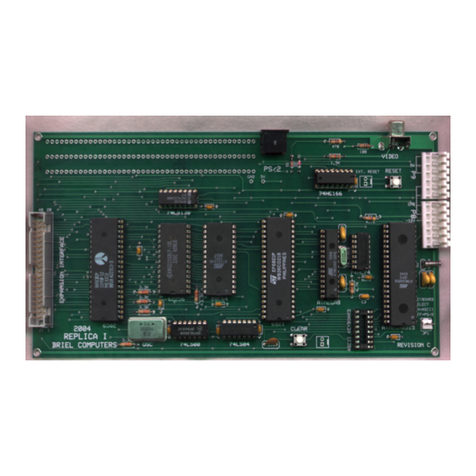
The system processor is the Western Design Center (WDC) 65C02 running at 1MHz to replicate the speed of
the original system. While the CPU can operate at a much higher rate of speed, this would cause programs to
not function as properly and video would be unable to keep up. The system comes with 32K RAM and that is
the same total as if the uperboard had the optional O I 610 board. Additional memory can be added with a
custom board to the expansion interface.
The system board operates at 3.3V so the power usage is much lower. As a result, you can power and operate
the uperboard /// right from the U B port of your PC or Mac. maller phone power supplies may not work as
they are only designed to power small phones. Using a power supply less than 1000mA could damage the
system board or the power supply or both. The U B interface is not just a power source, but a built in serial port
that can transmit and receive data to/from a PC or Mac. Using terminal software such as Hyper-Terminal, Tera
Term, or Zterm, you can send and receive data as if it was going to/from the cassette interface. Instead of 300
BAUD, the serial port is set at 9600 for faster data transmission. Because there is no hand shaking, delays must
be added when sending data to the uperboard ///.
The serial port takes the place of the cassette interface. The original cassette interface used the serial port at 300
BAUD and connected to an external cassette recorder. The process is slow, unreliable, and very tedious. till,
there are some who choose this method. The uperboard /// has a header onboard for accepting a cassette board.
The interface would be fairly simple requiring a voltage comparator, D/A circuit and a clock divider to reduce
the speed of the BAUD rate to 300. For simplicity of the system design, I did not put this onboard but added the
expansion header for a cassette interface.
As of the writing of this manual, there are 75 shift lock switches in possession for uperboard /// kits. These
Cherry MX click lock switches are out of production and very difficult to source. Once these run out, standard
switches will be substituted along with a slide switch for performing hift Lock functions. Why is shift lock so
important? Well, with out the characters shifted on power up, BA IC will not load. BA IC will not accept
commands that are not shifted, so it would be very difficult to hold a shift key for every alpha character.
There are five mounting holes on the board to secure it to a board or install it in a custom case. As of the writing
of this manual, there is no optional case for the uperboard /// but we hope to change that in the near future.
The BREAK key has an added delay of 3 seconds on it. This was added as a feature because it is very very easy
to hit the BREAK key. Think of the BREAK key as a RE ET switch, because that is what it is. When you press
it, the system resets and does a cold boot. Any programs you were working on are lost. Any data, gone. Now,
just hitting the button will not reset the board, you must hold it for 3 seconds. Another feature of the BREAK
key comes on power up. Pressing BREAK key on power up will put the video mode at 32x32 displayable video
page. Although BA IC still only uses lines of 25 characters, you get a 32 wide 32 high display to use. Power off
or RE ET the system board to change the display back.
The uperboard /// has that real vintage feel to it with modern conveniences added on. The kit is fairly easy to
build because the keyboard switches fit snug into the board and don't easily fall out. Relive the vintage
computing days and fire up your uperboard /// today!
© Briel Computers 2014 page




























